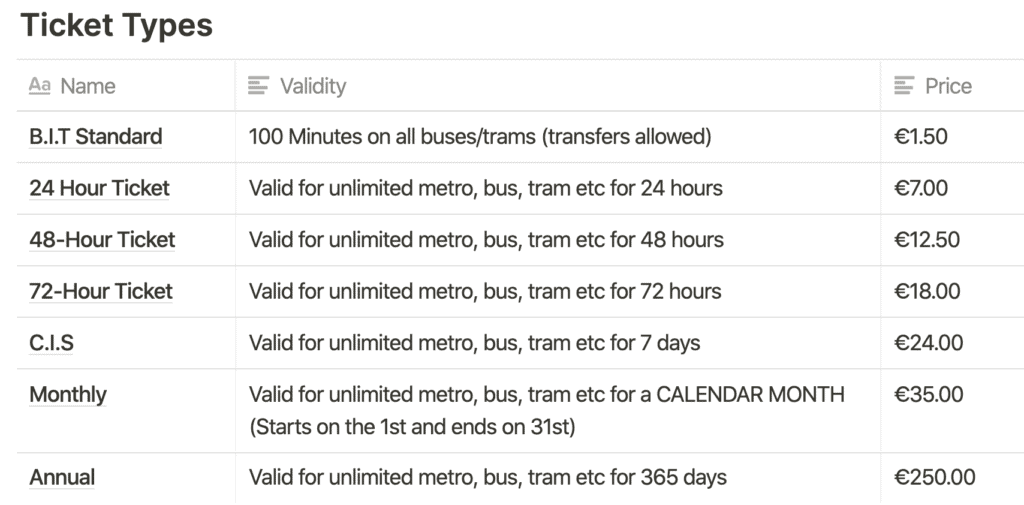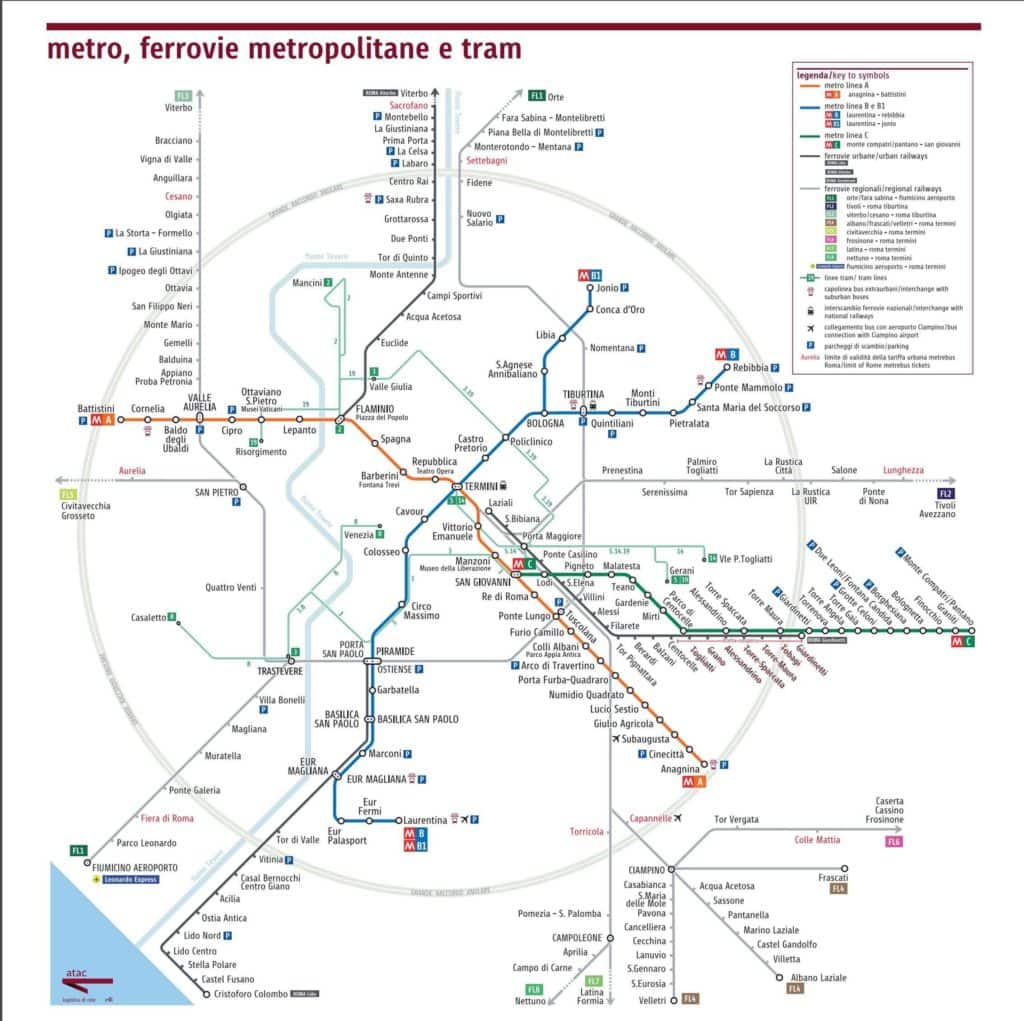I love the public transport system in Rome. It’s incredibly cheap and well connected, you just have to make sure to give yourself plenty of travel time. Whether you’re a student in La Sapienza and living in the city centre, or a student of Tor Vergata living on the outskirts you can easily zip around the city!
The price of a single fare that is valid for 100 minutes, on any form of public transport (allowing switching between the different types) within Rome is €1.50 Euro. However a monthly pass for unlimited travel within Rome 24 hours a day, for Metro, Tram and bus is only €35 Euro. Even though this is incredibly cheap, it gets even better as a yearly ticket of unlimited travel for Metro, Tram, bus AND intracity train is €250 Euro, and can be even cheaper depending on your family income and scholarships.
Ticket Types

Ticket Prices & Reductions
You can see from the table above how much each type of ticket can cost you, but depending on your ISEE (an Italian document that shows family income) it’s possible to get the annual ticket further reduced to €160 Euro. Coming from a country where transport is ludicrously expensive (€1500 a year for bus alone!) the prices in Rome are incredible.
Transport Types and Times
Buses
The buses run 24 hours a day, across perhaps 100s of routes. There are daytime routes and nighttime routes, but you are guaranteed to find a way to get home no matter the time albeit it might be a lot more difficult at night.
Day time buses generally start at around 5am and continue on until just before midnight. Night time buses serve less routes, for when the day time buses stop, but will generally have one to serve each of the main neighbourhoods in Rome connecting them to the centre.
Metros/Trams
There are technically 3 metro lines, but it would be more appropriate to consider it as 2.5 lines.
- There is the Orange (Linea A) line that connects Anagnina (Close to Tor Vergata Medical University) to Battistini (a bit further out than Vatican City).
- There is the Blue (Linea B) line that connects Laurentina to Rebibbia and Jonio via a line split at the Bologna stop (this is the stop most La Sapienza Medical students live close to)
- There is the Green (Linea C) line that is still under construction, but has stations you can travel between.
The lines connect to each other at different points so that you can switch such as Orange and Blue at Termini Station, or Green and Orange at San Giovanni Station. La Sapienza students have their own metro stop for the hospital called “Policlinico” so is quite convenient if they choose to live further from the city centre.
The Metros start around 05:30 am every morning and during the week will have the last metro depart from the terminal stations at 23:30pm. On weekends (Friday and Saturday nights), the metros run until 01:30 am. There are about 8 different tram lines and usually run from 6:00am until 11:30pm.
Downsides and Warnings
There are however three major downsides to public transport in Rome that I have to be honest about.
Always Late
First of all the buses are always late. Always. You will get lucky sometimes, but it’s probably the bus that was scheduled beforehand that is showing up at that time. I’m not joking, buses are very unreliable, but in a metropolitan city like Rome after you experience the nightmare of traffic you will understand why. Give yourself plenty of time if this is how you plan on getting around.
Transportation Strikes
There is almost always a monthly transportation strike, in which metros will not operate other than during peak hours, and maybe 1 out of 10 buses are running. The greatest mystery of my life in Rome is “What is ATAC (the transport company) striking for?”
I have asked every Italian I have ever met on my journey, and no one knows why they are striking. Higher pay? Fewer Hours? Union rights? Who knows.
Very Crowded
Finally Rome is one of the most touristic cities in the world, welcoming over 4.2 million visitors a year. This in addition to an already shocking 3.5 Million strong population, meaning that any form of transport during tourist season or peak hours is packed. I am not exaggerating when I say you have to push yourself on to a bus or metro to have a chance of getting on. It’s busy, really, really, really busy.
Bike and other forms of transport
Biking was not really a popular option in Rome due to the crazy traffic and road rage experienced by inhabitants. However biking is becoming an increasingly popular option among students and workers as the government is offering tax rebates to those who are buying bicycles and smaller electric transport options such as scooters. There has also been an increase in cycling paths, so in the past while I would have cautioned against it, this might be something that future students can start considering.
An increasingly popular form of transport is also electric scooters (not vespas, but the monopatente)! There are half a dozen different companies that provide 100s of scooters around the city for you to pick up and drop off within designated zones allowing you to speed around the city conveniently. It is also possible to rent electric bikes via these apps!
Where to get tickets?
All in all though, I believe the price that you pay for the monthly and yearly tickets is a bargain. Sure the buses are late and packed, but you can travel 24 hours a day from any part of Rome to another guaranteed, for essentially just over 20 euro a month.
To be able to get a monthly or yearly ticket you need to go to an ATAC office (I would recommend the one in Termini as its the most central one, however be warned it might be packed depending on the time of day). After taking a number and talking to a member of staff you can submit an application form along with your picture and payment to receive a personalised travel-pass that can be monthly or annual.
Please be aware that the monthly pass is 1 calendar month and must be topped up in a tabacchi. This means that if you refill your monthly pass on the 20th of the month, you will only be able to use it for 10 days, and pay the full price again the following month, so try to make sure you go within the first few days.
Single use tickets can be purchased at the tabacchi, at ticket machines near metro stops, or on an app called MyCicero.
Map of Rome Transport

